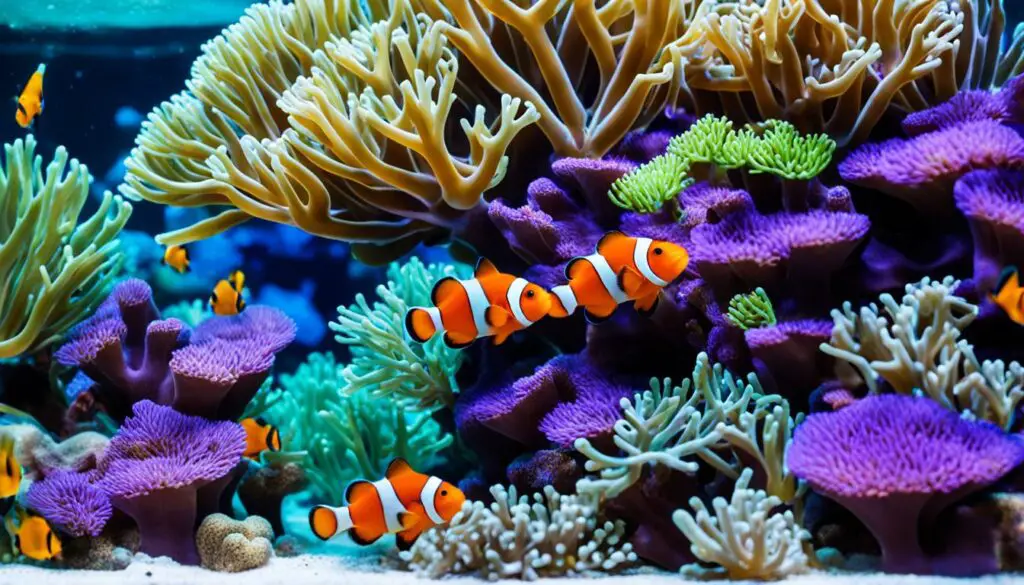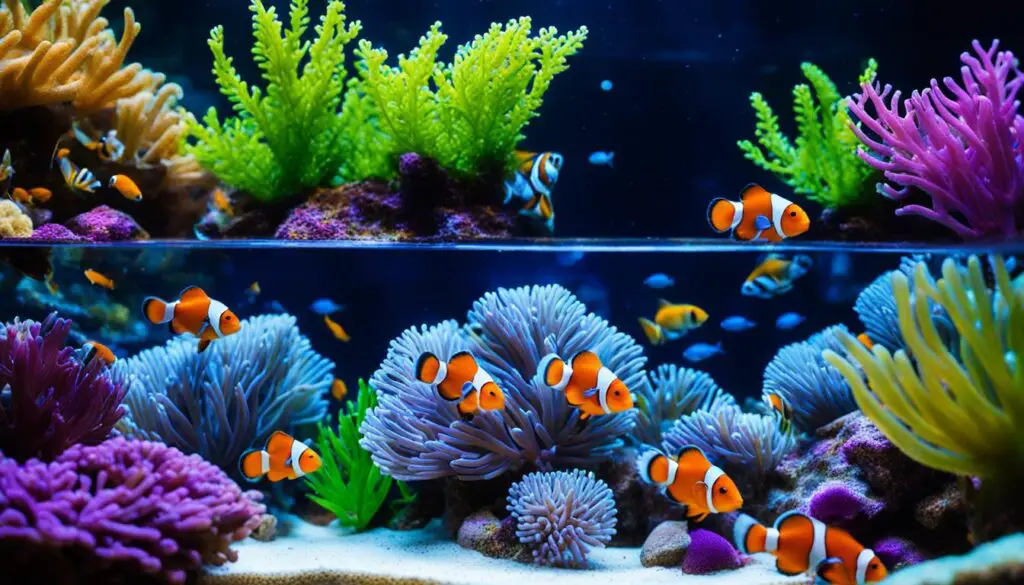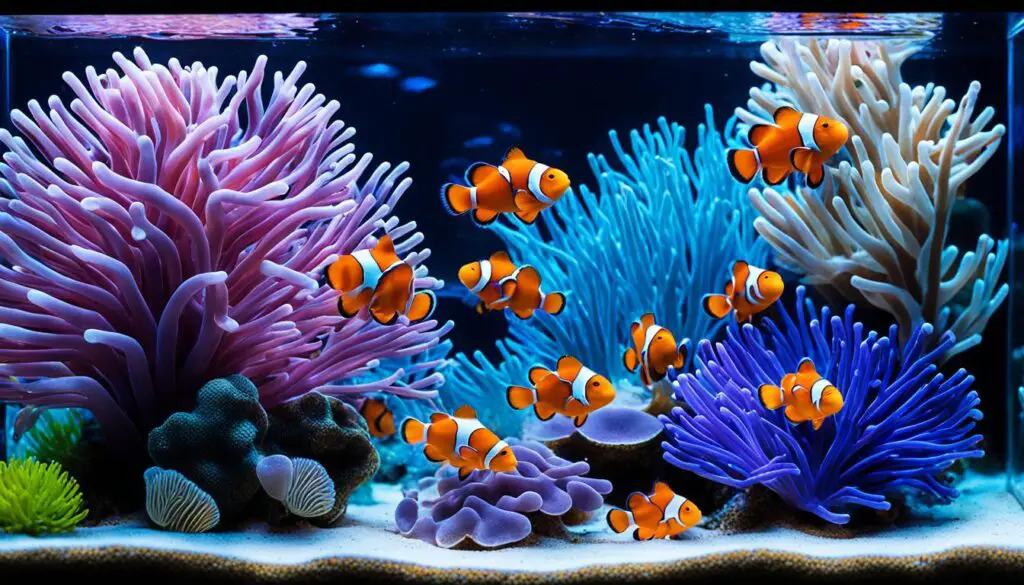Clownfish Tank Growth: Maximizing Health and Size
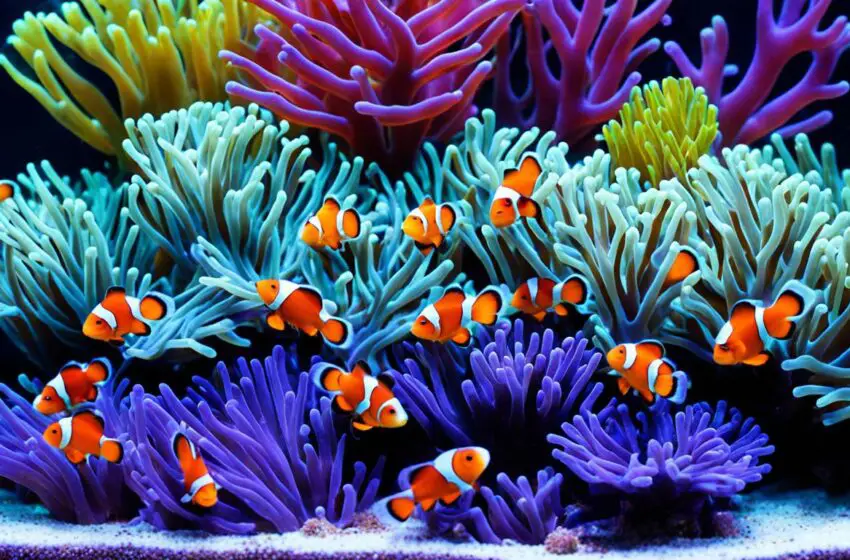
Are you a proud owner of a clownfish tank? Do you want them to thrive and be healthy? If your answer is yes, you’re in the right place. Here, you’ll find tips to help your clownfish grow and stay healthy in their tank.
Stocking density and diet are key for juvenile clownfish growth and survival. Learning about these can make your clownfish do well. I’ll also talk about how important it is to care for the environment. This is crucial when we take care of our fish friends.
Key Takeaways:
- Stocking density and diet influence the growth and health of clownfish in a tank.
- Implementing sustainable practices benefits the marine ornamental industry and the environment.
Choosing the Right Clownfish
Starting an aquarium is exciting, but choosing the right fish matters a lot. For beginners, it’s smart to pick clownfish that are easy to take care of. They should also get along with the other fish in your tank.
For those just starting, the Percula Clownfish is a great option. They have orange bodies with white stripes. Not only do they look amazing, but they are also easy to handle. This makes them perfect for new aquarium keepers.
However, before you add any clownfish, think about your aquarium’s needs. The water temperature and salinity levels are critical for these fish. Make sure your tank’s conditions match what the clownfish need.
Pro Tip: Look up what environment your clownfish need. This knowledge will make them happier and healthier in your tank.
If you want another good option, check out the Ocellaris Clownfish. They are similar to the Percula but with more black. Ocellaris Clownfish are also easy to manage and look great. They add a level of sophistication to any tank.
Keeping your tank environment healthy is crucial for your clownfish. This means having the right water conditions and a good filter. A happy tank ensures your fish will live longer and better.
In short, for a successful aquarium, start with easy-going clownfish like the Percula or Ocellaris. Do your homework on their needs. Keeping their environment just right will let them flourish.
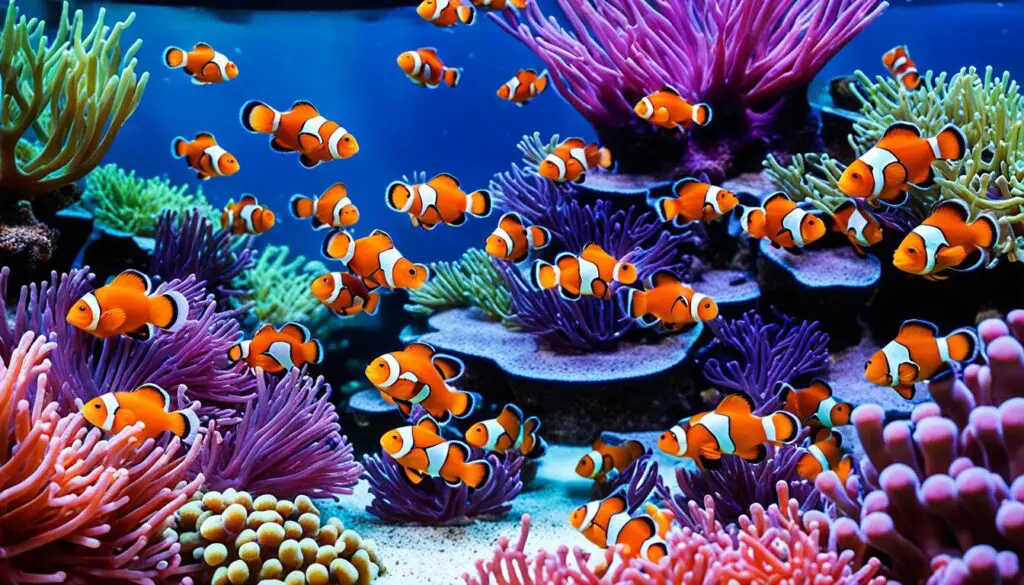
A Comparison of Beginner Clownfish Species
| Species | Main Characteristics | Tank Compatibility |
|---|---|---|
| Percula Clownfish | Bright orange body with white stripes | Compatible with a wide range of tank sizes and ecosystems |
| Ocellaris Clownfish | Vibrant orange body with bold black markings | Well-suited for beginner tanks with stable water parameters |
Understanding Different Clownfish Varieties
Clownfish come in many types, each with its own special look and actions. They are great for any fish tank. Let’s look at three favorites: Percula Clownfish, Ocellaris Clownfish, and Full Stripe Black and White Clownfish.
Percula Clownfish
The Percula Clownfish, also called the False Percula, is famous from “Finding Nemo.” It’s bright orange with black edges and three white stripes.
These fish are small, about 3 inches long, and love to play. They make the tank lively and can live in pairs or groups.
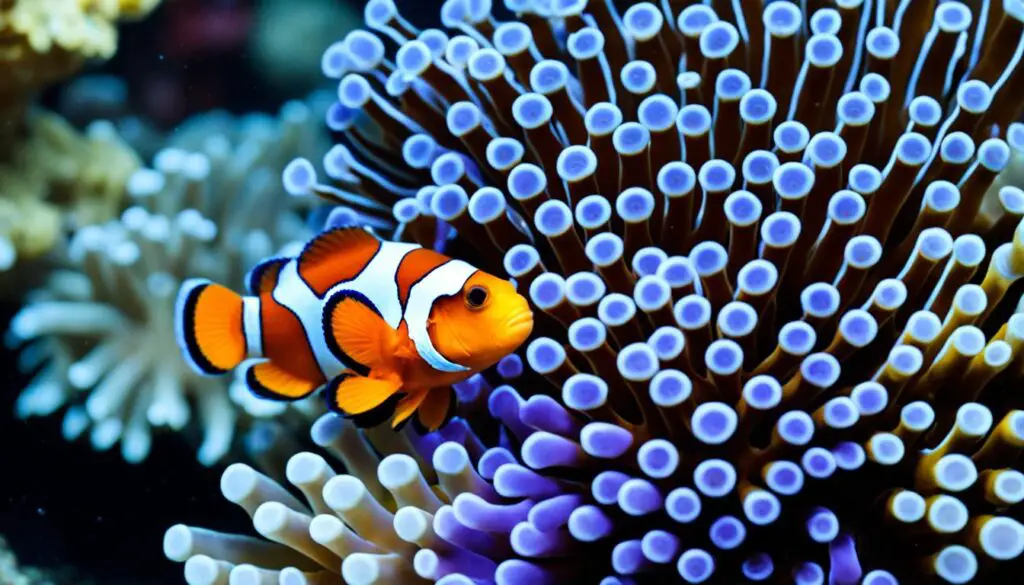
Ocellaris Clownfish
Ocellaris Clownfish look similar to Perculas but have their own charm. They’re friendly and are great for beginners.
They do something amazing. They live with sea anemones in a way that both help each other.
Full Stripe Black and White Clownfish
The Full Stripe Black and White Clownfish really catch the eye. They’re black and white, unlike other types.
But they’re not just pretty. They’re fun and like to explore, adding life to any tank.
Choosing a clownfish is fun. Think about what they offer when adding to your tank. You’ll enjoy a beautiful, active aquarium.
Creating the Ideal Aquarium Environment for Clownfish
Setting up the perfect home for clownfish involves several important steps. First, choose a large enough tank for them. Clownfish need plenty of space to swim and grow. A 20-gallon tank or larger is best for their health.
Keeping the water right is vital. Check the tank’s temperature, salt levels, and pH often. Clownfish are happiest in water that is 75 to 82 degrees Fahrenheit. The salt level should be between 1.020 and 1.025. Use a good water testing kit to maintain these levels.
Creating a natural habitat for clownfish is important. Add live rocks, corals, and anemones to the tank. Not only does this make the tank look nice, but it also gives the fish places to hide and explore. They may even form special bonds with anemones.
Choosing the right tank mates is the final step. Select peaceful fish, such as gobies or damselfishes. Always check with an aquarium expert before adding new fish. This keeps a calm and happy community for your clownfish.
FAQ
What is the ideal stocking density for clownfish in a tank?
The ideal stocking density is one inch of fish per three to five gallons of water. This rate helps prevent overcrowding. It ensures the clownfish stay healthy and happy.
What should I feed my juvenile clownfish to promote their growth and health?
For young clownfish, feed them high-quality food like pellets and flakes. Add in some frozen or live food, such as brine shrimp. This will help them grow and stay healthy.
How do I select clownfish that are compatible with my tank’s ecosystem?
When picking clownfish, look at your tank’s temperature and the other fish you have. Make sure they can all live together happily. This step is vital for the clownfish to thrive.
What are the unique features and behaviors of the Percula Clownfish?
The Percula Clownfish stands out with its bright orange look and three white stripes. It loves hanging out with anemones. The fish is known for staking out its own territory.
How can I recreate the natural habitat of clownfish in my tank?
To make your tank feel like home to clownfish, use corals, rocks, and anemones. Only choose anemones that the clownfish can live in. This setup is key for their health and happiness.
What tank mates are suitable for clownfish?
Clownfish get along with peaceful friends like damselfish, gobies, and blennies. Stay away from fish that like to fight or have big personalities. Always add new friends slowly and watch how they get along.
How do I maintain proper water parameters for my clownfish?
Keeping the water just right means checking the temperature, salt levels, pH, and ammonia often. Change some of the water regularly. Good filters can also help keep the water clean for your clownfish.
What is the recommended tank size for clownfish?
A 20-gallon tank is a good start for a pair of clownfish. Bigger tanks are even better. They offer more room to explore and create a stable home for the fish.
How do sustainable practices benefit the marine ornamental industry?
Being sustainable means taking care not to harm the wild fish when we catch them. It also involves breeding the fish we like in tanks. These actions help protect the oceans and keep the fish we love around for the future.

